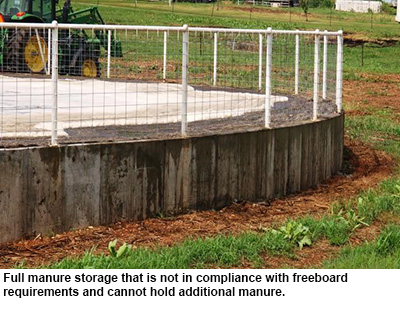Strategies for maintaining nutrient quality when applying manure early
This is part 2 of a two-part series on safety and quality considerations for early fall pit manure removal and application.
9/6/24
 AMES, Iowa –
After a wet spring, storage capacity might be tighter than usual, especially for out-of-barn manure storages, and an increasing potential for a slighter later harvest and application season. Daniel Andersen, associate professor of agricultural and biosystems engineering at Iowa State University, said if manure storages are nearing their limits, the risk of an overflow event becomes a pressing concern.
AMES, Iowa –
After a wet spring, storage capacity might be tighter than usual, especially for out-of-barn manure storages, and an increasing potential for a slighter later harvest and application season. Daniel Andersen, associate professor of agricultural and biosystems engineering at Iowa State University, said if manure storages are nearing their limits, the risk of an overflow event becomes a pressing concern.
"Overflow events are not just messy. They can lead to serious environmental problems and potential regulatory fines," he said. "In such cases, it's better to apply manure earlier than planned."
Once you've decided that an early fall application is necessary, the next step is to ensure the nutrients in the manure are still available to your crops in the next growing season. Andersen offers a few strategies to help you achieve the availability.
"Instead of applying all your manure at once, consider applying just enough to free up storage space and push your main application to later in the fall when temperatures are cooler," he said. "Cooler temperatures slow down the conversion of nitrogen into forms that are more likely to be lost before the crops can use them."
If you have to apply manure early, planting cover crops can be one of the best defenses. Cover crops absorb the nitrogen applied with manure, holding it in place and preventing it from leaching out of the soil.
"You might want to cut back on your manure application rate slightly when using cover crops, Andersen said. "This will leave some room in your nitrogen budget for supplemental applications at planting or shortly after, helping to offset any nitrogen that gets tied up as the cover crop residue decomposes."
Although nitrification inhibitors aren't a perfect solution for long-term nutrient preservation, they can be effective in the short term. If manure is applied in early September, a nitrification inhibitor can help keep nitrogen in its ammonium form for a few weeks, reducing the risk of nitrogen loss before the crop is ready to take it up.
While early fall isn't ideal for manure application, safety concerns and logistical challenges sometimes make it necessary, he said. The key is to take proactive steps to ensure that the nutrients in your manure are preserved and ready for your crops in the next growing season.
"By safely agitating your pits, using pit treatments, planting cover crops, adjusting your application rates, and considering nitrification inhibitors, you can manage the risks associated with early application while reaping the benefits of your manure," Andersen said. "Remember, the goal is to keep your operation safe and efficient while maximizing the value of your manure. With careful planning and the right strategies, you can achieve both."
Part 1 of this series looks at safety considerations for manure agitation and removal.
-30-
IPIC was established in 1994 as a coordinated effort of the colleges of Agriculture (now Agriculture and Life Sciences) and Veterinary Medicine at ISU. Its mission is to promote efficient pork production technologies in Iowa, maintain Iowa's pork industry leadership and strengthen rural development efforts. IPIC focuses its efforts on programs that are integral and complementary to ISU Extension and Outreach. Through IPIC, Iowa producers receive accurate and timely information to make their operations more efficient and profitable.
Contact
Dan Andersen
Agricultural and Biosystems Engineering
Writer
Sherry Hoyer
Communications Specialist

